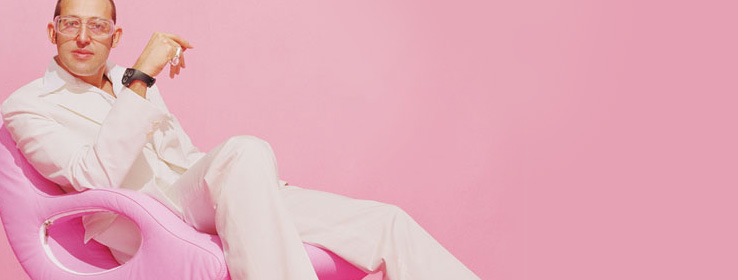Technology brings us closer to designer Karim Rashid's vision of a bright, modernist future.
Product designer Karim Rashid has always been a modernist. "It's the way I see the world,” he says. With more than 2,000 objects put into production, Rashid has applied his minimalist aesthetic to clients as diverse as Nambe, Mikasa, Prada and Umbra, and has been credited with bringing modern design to the masses. Dubbed "the poet of plastic” by Time magazine in 2001, Rashid has now branched into interior design.
STIR: We've been hearing that modernism is on the rise. What's your view?
KR: No question about it, we're living in a more contemporary world. We'll see a huge change in 10 or 15 years. There's still a lot of money with the older market, but as youth become well off, contemporary style will grow.
STIR: Why do you think that's happening?
KR: All artifacts speak about the period in which we live. In the last century, we regressed so much, as if we had no future. We thought we'd live on the moon, then we went and there was nothing there — just dead rock. We lost our optimism about outer space and regressed to earthy colors. We were replicating the past. Now it's all breaking loose. We're starting to see new optimism for the future. Technology is affording us a better world.
STIR: How will that influence color?
KR: When we're really optimistic, color moves in. We saw it in the original pop movement in the '50s, after World War II. The economy was strong, and there was optimism about the future. I think we've accepted color again in the past five years. It's a beautiful phenomenon. We're born with this gift, to see color. Then we get afraid of it. Color is something to celebrate and enjoy. It's odd that we think it's something for children.
STIR: What's the design impact of the digital revolution?
KR: It's an interesting time we're living in, a time of customization. Thirty or 40 years ago, you could have things hand-painted any color. Then we went to mass production and just a few color choices. Now we're going back to choice through technology and digital color. For the first time, design has become democratic. We can publish at our desktops, customize our Nikes, make our own shampoo and edit our own movies. Now we're looking at the rest of our environment and wondering, "Why do I have these incredibly beautiful high-tech products and this derivative 18th-century couch?”
STIR: How is technology changing the way we live?
KR: Soon we won't need a key for the door. A sensor will let us in. You won't need to turn on lights; light will follow you around your home. My bathroom in New York is all motion sensors; I don't touch my tap or flush my toilet. These ideas used to be science fiction; now they're here. Soon they will be affordable enough for the masses.
STIR: You made your name designing consumer products. Why did you decide to branch into interior design?
KR: You can really affect a person's psyche — it's more of a sensory experience. My theory is that if a product is really good, it can exist in any color, and with mass production, you can go in all different directions — you can experiment. But in interior design, you only have one chance to get it right. I recently did a restaurant in Belgrade, and I changed my mind about the floor 20 times. First it was high-gloss pink, with lines like an old mosaic. Then high-gloss black. Then gray.
STIR: So what did you end up with?
KR: White. (Laughs.) Isn't that sad? But the rest of the space was so over the top with color and imagery that it needed white.
STIR: What were your early color and design influences?
KR: My father was a set designer for TV and film, and that probably had a lot of impact on me. He painted super graphics in the house, and we had a big plastic high-gloss orange clock.
STIR: What colors do you choose in your own life?
KR: For five years, I've been wearing only white. It's a blank canvas. I took all my black clothes to the Salvation Army. My home is crazy — fluorescent orange, bright pink and plums. I change my apartment about every month. I'm kind of obsessed with change.
STIR: Do you have a signature color?
KR: Pink. I was always fascinated with pink as a child. At my high school graduation (in Toronto), I wore a custom-made pink satin suit and dyed my hair pink. A few years ago, British GQ said, "Karim made pink masculine,” which I love.
STIR: What are you most excited about right now, with respect to color?
KR: The colors I'm into now are iridescent and changeable. I recently did a park bench in Japan that looks gold, pink or orange, depending on the angle. It's color with depth.
STIR: What color or design trend would you like to see go away?
KR: What I wish would go away is this notion that "cozy” is a big fat fluffy couch with pillows. That's an old idea of what cozy is. You could get a big contemporary couch that was more comfortable. There's a weird mentality about wood. People immediately want it. They fear plastic. But plastic is so superior! It can outperform wood, it's lightweight and it's recyclable. It's time to accept it.
For more information, visit www.karimrashid.com.




